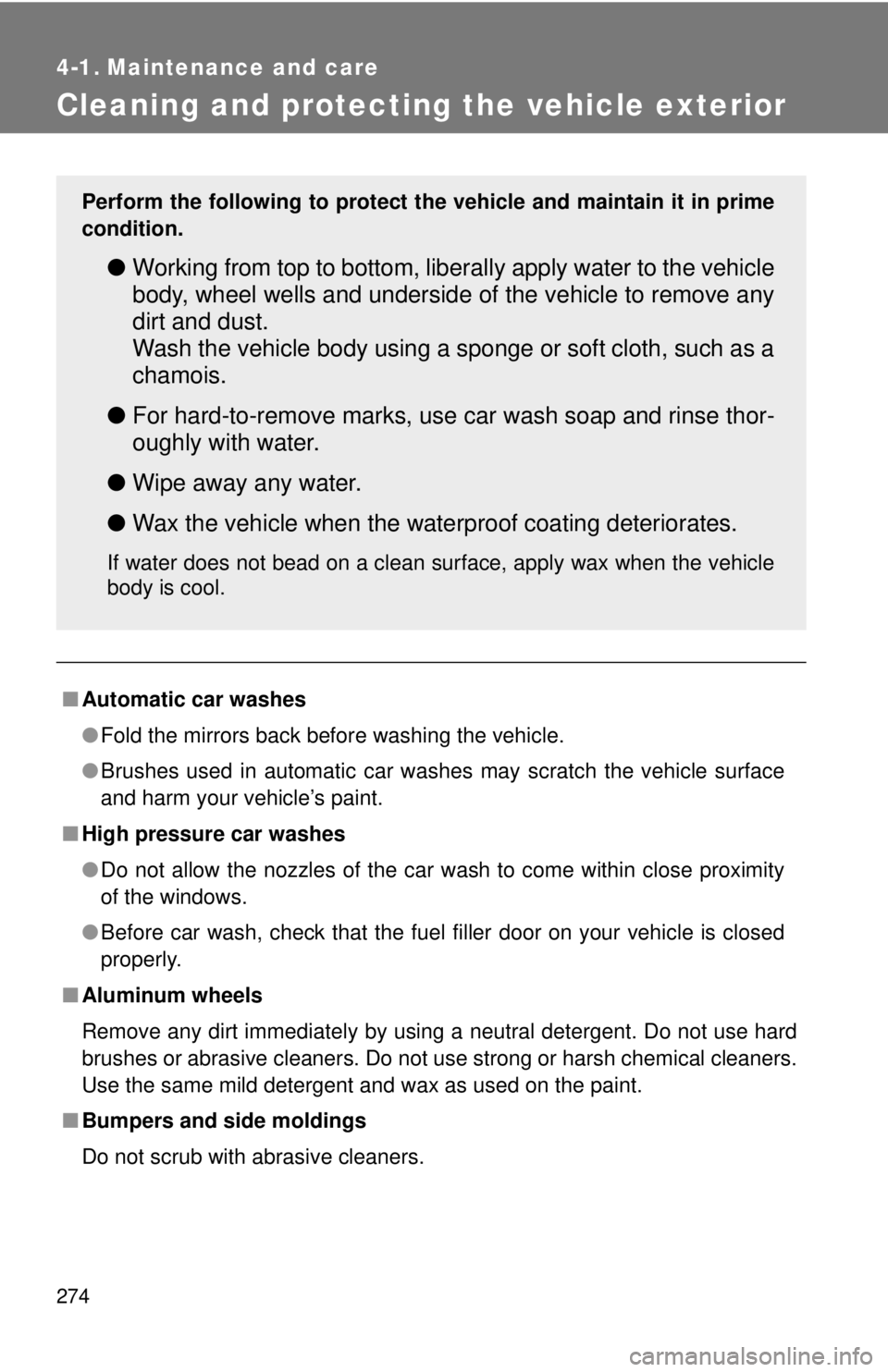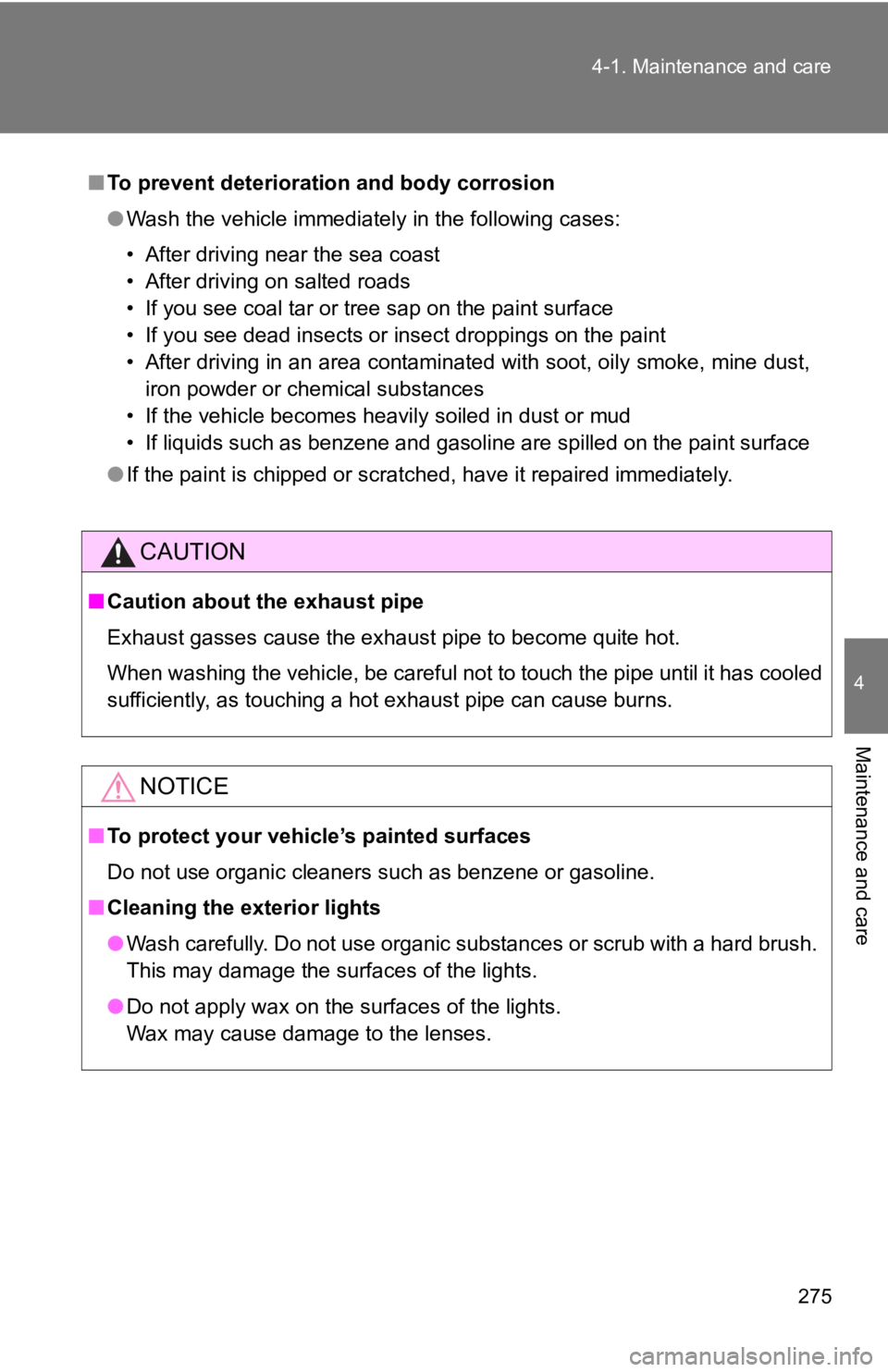Page 1 of 444
TABLE OF CONTENTS
1
1Before driving
Information on the hybrid system and adjusting and op-
erating features such as door locks, mirrors, and steer-
ing column.
2When drivingDriving, stopping and safe-driving information.
3Interior fea-
turesAir conditioning and audio systems, as well as other in-
terior features for a comfortable driving experience.
4Maintenance
and careCleaning and protecting your vehicle, performing do-it-
yourself maintenance, and maintenance information.
5When trouble
arisesWhat to do if the vehicle needs to be towed, gets a flat
tire, or is involved in an accident.
6Vehicle
specificationsDetailed vehicle information.
7For ownersReporting safety defects for U.S. owners and seat belt
instructions for Canadian owners
IndexAlphabetical listing of information contained in this
manual.
Page 4 of 444

TABLE OF CONTENTSIndex
4
Trunk features .................... 263
Garage door opener ........... 264
Compass ............................ 269
4-1. Maintenance and care...... 274 Cleaning and protecting the vehicle exterior ........... 274
Cleaning and protecting the vehicle interior ............ 276
4-2. Maintenance ..................... 279 Maintenance requirements .................... 279
General maintenance ......... 281
Emission inspection and maintenance (I/M)
programs .......................... 284
4-3. Do-it-yourself maintenance ................... 285
Do-it-yourself service precautions ...................... 285
Hood................................... 288
Positioning a floor jack ....... 289
Engine compartment .......... 291
12-volt battery .................... 300
Tires ................................... 304
Tire inflation pressure......... 313
Wheels ............................... 317
Air conditioning filter ........... 319
Key battery ......................... 322
Checking and replacing fuses ................................ 325
Light bulbs .......................... 336 5-1. Essential information ....... 342
If your vehicle needs to be towed ........................... 342
If you think something is wrong ................................ 345
Event data recorder ............ 346
5-2. Steps to take in an emergency ...................... 348
If a warning light turns on or a warning buzzer
sounds... .......................... 348
If a warning message is displayed .......................... 357
If you have a flat tire ........... 368
If the hybrid system will not start ............................ 378
If the shift lever cannot be shifted from P ................... 380
If you lose your keys ........... 381
If the electronic key does not operate properly ......... 382
If the vehicle’s 12-volt battery is discharged ........ 385
If your vehicle overheats..... 389
If the vehicle becomes stuck ................................. 393
4Maintenance and care
5When trouble arises
Page 5 of 444
1
2
3
4
5
6
7
5
6-1. Specifications.................... 396Maintenance data (fuel, oil level, etc.) ............ 396
Fuel information .................. 406
Tire information ................... 409
6-2. Customization ................... 421 Customizable features ........ 421
6-3. Initialization ....................... 424 Items to initialize ................. 424
Reporting safety defects for U.S. owners ................. 426
Seat belt instructions for Canadian owners
(in French) ........................ 427
Abbreviation list ........................ 432
Alphabetical index ..................... 433
What to do if... ........................... 442
6Vehicle specifications
7For owners
Index
Page 24 of 444

24 1-1. Hybrid system
●To help prevent the 12-volt battery from becoming discharged, drive the
vehicle at least once a month, and operate the accessories only when
the “READY” indicator is on. When parking the vehicle, make sure the
doors and trunk are closed and all lights are turned off.
■ After the 12-volt battery has di scharged or has been changed or
removed
The gasoline engine may not stop even if the vehicle is running on the hybrid
battery (traction battery). If this continues for a few days, contact your Toyota
dealer.
■ Sounds and vibrations specific to a hybrid vehicle
There may be no engine sounds or vibration even though the vehicle is able
to move. Always put the shift lever in P when parked.
The following sounds or vibrations may occur when the hybrid system is
operating, and are not a malfunction:
●Motor sounds may be heard from the engine compartment.
● Sounds may be heard from the hybrid battery (traction battery) behind
the rear seat when the hybrid system starts or stops.
● Sounds may be heard from the transaxle when the hybrid system starts
or stops, or while the vehicle is idling.
● Engine sounds may be heard when accelerating sharply.
● Sounds may be heard due to the regenerative braking when you press
the brake pedal.
● Vibration may be felt when the gasoline engine starts or stops.
● Cooling fan sounds may be heard from the air intake vents behind the
rear seat.
■ Maintenance, repair, recycling, and disposal
Contact your Toyota dealer regarding maintenance, repair, recycling and dis-
posal. Do not dispose of the vehicle yourself.
Page 83 of 444

83
1
Before driving
1-7. Theft deterrent system
Immobilizer system
■System maintenance
The vehicle has a maintenance-free type of immobilizer system.
■ Conditions that may cause the system to malfunction
● If the key is in contact with a metallic object
● If the key is in close proximity to or touching a key to the security system
(key with a built-in transponder chip) of another vehicle
■ Certifications for the immobilizer system
For vehicles sold in U.S.A.
FCC ID: NI4TMIMB-1
This device complies with Part 15 of the FCC Rules. Operation is subject to
the following two conditions: (1) this device may not cause harmful interfer-
ence, and (2) this device must accept any interference received, including
interference that may cause undesired operation.
The vehicle's keys have built-in tran sponder chips that prevent the
hybrid system from starting if th e key has not been previously regis-
tered in the vehicle's on-board computer.
Never leave the keys inside the vehicle when you leave the vehicle.
The indicator light flashes after
the “POWER” switch has been
turned OFF to indicate that the
system is operating.
Page 273 of 444
Maintenance and care4
273
4-1. Maintenance and care ............................... 274
Cleaning and protecting the vehicle exterior......... 274
Cleaning and protecting the vehicle interior.......... 276
4-2. Maintenance ................... 279 Maintenance requirements .................. 279
General maintenance....... 281
Emission inspection and maintenance (I/M)
programs........................ 284 4-3. Do-it-yourself
maintenance ................. 285
Do-it-yourself service precautions .................... 285
Hood ................................ 288
Positioning a floor jack ..... 289
Engine compartment ........ 291
12-volt battery .................. 300
Tires ................................. 304
Tire inflation pressure ...... 313
Wheels ............................. 317
Air conditioning filter......... 319
Key battery ....................... 322
Checking and replacing fuses .............................. 325
Light bulbs........................ 336
Page 274 of 444

274
4-1. Maintenance and care
Cleaning and protecting the vehicle exterior
■Automatic car washes
●Fold the mirrors back before washing the vehicle.
● Brushes used in automatic car washes may scratch the vehicle surface
and harm your vehicle’s paint.
■ High pressure car washes
●Do not allow the nozzles of the car wash to come within close proximity
of the windows.
● Before car wash, check that the fuel filler door on your vehicle is closed
properly.
■ Aluminum wheels
Remove any dirt immediately by using a neutral detergent. Do not use har\
d
brushes or abrasive cleaners. Do not use strong or harsh chemical cleaners.
Use the same mild detergent and wax as used on the paint.
■ Bumpers and side moldings
Do not scrub with abrasive cleaners.
Perform the following to protect the vehicle and maintain it in prime
condition.
● Working from top to bottom, liber ally apply water to the vehicle
body, wheel wells and underside of the vehicle to remove any
dirt and dust.
Wash the vehicle body using a sponge or soft cloth, such as a
chamois.
● For hard-to-remove marks, use car wash soap and rinse thor-
oughly with water.
● Wipe away any water.
● Wax the vehicle when the waterproof coating deteriorates.
If water does not bead on a clean surface, apply wax when the vehicle
body is cool.
Page 275 of 444

275
4-1. Maintenance and care
4
Maintenance and care
■
To prevent deterioration and body corrosion
●Wash the vehicle immediately in the following cases:
• After driving near the sea coast
• After driving on salted roads
• If you see coal tar or tree sap on the paint surface
• If you see dead insects or insect droppings on the paint
• After driving in an area contaminated with soot, oily smoke, mine dust,
iron powder or chemical substances
• If the vehicle becomes heavily soiled in dust or mud
• If liquids such as benzene and gasoline are spilled on the paint surface
● If the paint is chipped or scratched, have it repaired immediately.
CAUTION
■Caution about the exhaust pipe
Exhaust gasses cause the exhaust pipe to become quite hot.
When washing the vehicle, be careful not to touch the pipe until it has cooled
sufficiently, as touching a hot exhaust pipe can cause burns.
NOTICE
■To protect your vehicle’s painted surfaces
Do not use organic cleaners such as benzene or gasoline.
■ Cleaning the exterior lights
●Wash carefully. Do not use organic substances or scrub with a hard brush.
This may damage the surfaces of the lights.
● Do not apply wax on the surfaces of the lights.
Wax may cause damage to the lenses.